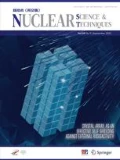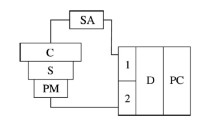Abstract
A newly developed digital data acquisition system, which is based on the digital pulse processor Pixie-16 modules by XIA LLC, was tested with the \(\gamma\)-ray detector array of the China Institute of Atomic Energy using the \(\gamma\)-ray source and in-beam \(\gamma\)-rays. A comparison between this digital data acquisition system and the conventional analog data acquisition system was made. At a low count rate, both systems exhibit good and comparable energy resolutions. At a high count rate above 8.8 k/s, while the energy resolution obtained by the analog system deteriorates significantly, the energy resolution obtained by the digital system is nearly unchanged. Meanwhile, experimental data with higher statistics can be collected by the digital system. The advantage of this digital system over the conventional analog system can be ascribed to its excellent capability of handling pile-up pulses at higher count rates, and the fact that it has nearly no dead time in data transmission and conversion.







Similar content being viewed by others
References
J. Eberth, J. Simpson, From Ge(Li) detectors to gamma-ray tracking arrays-50 years of gamma spectroscopy with germanium detectors. Prog. Part. Nucl. Phys. 60, 283–337 (2008). https://doi.org/10.1016/j.ppnp.2007.09.001
M.A. Riley, J. Simpson, E.S. Paul, High resolution gamma-ray spectroscopy and the fascinating angular momentum realm of the atomic nucleus. Phys. Scr. 91, 123002 (2016). https://doi.org/10.1088/0031-8949/91/12/123002
M.J. Koskelo, I.J. Koskelo, B. Sielaff, Comparison of analog and digital signal processing systems using pulsers. Nucl. Instrum. Methods Phys. A 422, 373–378 (1999). https://doi.org/10.1016/S0168-9002(98)00986-3
S. Mitra, L. Wielopolski, G. Hendrey, Comparison of a digital and an analog signal processing system for neutron inelastic gamma-ray spectrometry. Appl. Radiat. Isot. 61, 1463–1468 (2004). https://doi.org/10.1016/j.apradiso.2004.02.024
W.K. Warburton, P.M. Grudberg, Current trends in developing digital signal processing electronics for semiconductor detectors. Nucl. Instrum. Methods Phys. A 568, 350–358 (2006). https://doi.org/10.1016/j.nima.2006.07.021
A. Al-Adili, F.-J. Hambsch, S. Oberstedt et al., Comparison of digital and analogue data acquisition systems for nuclear spectroscopy. Nucl. Instrum. Methods Phys. A 624, 684–690 (2010). https://doi.org/10.1016/j.nima.2010.09.126
P. Wang, R.Y. Zhang, Y.Y. Yan et al., An acquisition system of digital nuclear signal processing for the algorithm development. Nucl. Sci. Tech. 24, 060408 (2013). https://doi.org/10.13538/j.1001-8042/nst.2013.06.012
R.S. Dong, L. Zhao, J.J. Qin et al., Design of a 20-Gsps 12-bit time-interleaved analog-to-digital conversion system. Nucl. Sci. Tech. 32, 25 (2021). https://doi.org/10.1007/s41365-021-00863-5
H.C. Scraggs, C.J. Pearson, G. Hackman et al., TIGRESS highly-segmented high-purity germanium clover detector. Nucl. Instrum. Methods Phys. A 543, 431–440 (2005). https://doi.org/10.1016/j.nima.2004.12.012
J.-P. Martin, C. Mercier, N. Starinski et al., The TIGRESS DAQ/trigger system. IEEE Trans. Nucl. Sci. 55, 84–90 (2008). https://doi.org/10.1109/TNS.2007.910853
M. Descovich, I.Y. Lee, P. Fallon et al., In-beam measurement of the position resolution of a highly segmented coaxial germanium detector. Nucl. Instrum. Methods Phys. A 553, 535–542 (2005). https://doi.org/10.1016/j.nima.2005.07.016
W.F. Mueller, J.A. Church, T. Glasmacher et al., Thirty-two-fold segmented germanium detectors to identify \(\gamma\)-rays from intermediate-energy exotic beams. Nucl. Instrum. Methods Phys. A 466, 492–498 (2001). https://doi.org/10.1016/S0168-9002(01)00257-1
K. Starosta, C. Vaman, D. Miller et al., Digital data acquisition system for experiments with segmented detectors at National Superconducting Cyclotron Laboratory. Nucl. Instrum. Methods Phys. A 610, 700–709 (2009). https://doi.org/10.1016/j.nima.2009.09.016
C.J. Prokop, S.N. Liddick, B.L. Abromeit et al., Digital data acquisition system implementation at the National Superconducting Cyclotron Laboratory. Nucl. Instrum. Methods Phys. A 741, 163–168 (2014). https://doi.org/10.1016/j.nima.2013.12.044
P.-A. Söderström, F. Recchia, J. Nyberg et al., Interaction position resolution simulations and in-beam measurements of the AGATA HPGe detectors. Nucl. Instrum. Methods Phys. A 638, 96–109 (2011). https://doi.org/10.1016/j.nima.2011.02.089
S. Akkoyun, A. Algora, B. Alikhani et al., AGATA-advanced gamma tracking array. Nucl. Instrum. Methods Phys. A 668, 26–58 (2012). https://doi.org/10.1016/j.nima.2011.11.081
R. Palit, S. Saha, J. Sethi et al., A high speed digital data acquisition system for the Indian National gamma array at Tata Institute of Fundamental Research. Nucl. Instrum. Methods Phys. A 680, 90–96 (2012). https://doi.org/10.1016/j.nima.2012.03.046
S. Das, S. Samanta, R. Banik et al., A Compton suppressed detector multiplicity trigger based digital DAQ for gamma-ray spectroscopy Author links open overlay panel. Nucl. Instrum. Methods Phys. A 893, 138–145 (2018). https://doi.org/10.1016/j.nima.2018.03.035
H.Y. Wu, Z.H. Li, H. Tan et al., A general-purpose digital data acquisition system (GDDAQ) at Peking University. Nucl. Instrum. Methods Phys. A 975, 164200 (2020). https://doi.org/10.1016/j.nima.2020.164200
J.G. Wang, S.J. Zhu, L. Gu et al., High-spin states and collective band structures in the odd–odd \(^{140}\)Pm nucleus. J. Phys. G Nucl. Part. 37, 125107 (2010). https://doi.org/10.1088/0954-3899/37/12/125107
XIA LLC, https://xia.com/
H. Tan, W. Hennig, M. Walby et al., Digital data acquisition modules for instrumenting large segmented germanium detector arrays, in 2008 IEEE Nuclear Science Symposium Conference Record (2008), pp. 3196–3200. https://doi.org/10.1109/NSSMIC.2008.4775029
W. Hennig, H. Tan, M. Walby et al., Clock and trigger synchronization between several chassis of digital data acquisition modules. Nucl. Instrum. Methods Phys. B 261, 1000–1004 (2007). https://doi.org/10.1016/j.nimb.2007.04.181
S.W. Smith, The Scientist and Engineer’s Guide to Digital Signal Processing, 2nd edn. (California Technical Publishing, San Diego, 1999), pp. 277–282
V.T. Jordanov, G.F. Knoll, Digital synthesis of pulse shapes in real time for high resolution radiation spectroscopy. Nucl. Instrum. Methods Phys. A 345, 337–345 (1994). https://doi.org/10.1016/0168-9002(94)91011-1
V.T. Jordanov, G.F. Knoll, A.C. Hubera et al., Digital techniques for real-time pulse shaping in radiation measurements. Nucl. Instrum. Methods Phys. A 353, 261–264 (1994). https://doi.org/10.1016/0168-9002(94)91652-7
D.C. Radford, ESCL8R and LEVIT8R: Software for interactive graphical analysis of HPGe coincidence data sets. Nucl. Instrum. Methods Phys. A 361, 297–305 (1995). https://doi.org/10.1016/0168-9002(95)00183-2
ROOT Data Analysis Framework, https://root.cern.ch//
E.K. Warburton, J.W. Olness, A.M. Nathan et al., Yrast decay schemes from heavy-ion + \(^{48}{\rm Ca}\) fusion-evaporation reactions. II. \(^{59-60}{\rm Fe}\) and \(^{59-60}{\rm Co}\). Phys. Rev. C 16, 1027–1039 (1977). https://doi.org/10.1103/PhysRevC.16.1027
Evaluated Nuclear Structure Data File (ENSDF), http://www.nndc.bnl.gov/ensdf
Acknowledgements
The authors wish to thank X.G. Wu, Y. Zheng, C.B. Li, H. Tan, and W. Hennig for their great help during testing of this DDAQ.
Author information
Authors and Affiliations
Contributions
All authors contributed to the study conception and design. Material preparation, data collection, and analysis were performed by Di-Wen Luo, Hong-Yi Wu, and Zhi-Huan Li. The first draft of the manuscript was written by Di-Wen Luo and all authors commented on previous versions of the manuscript. All authors read and approved the final manuscript.
Corresponding authors
Additional information
This work was supported by the National Key R&D Program of China (No. 2018YFA0404403), the National Natural Science Foundation of China (Nos. 12035001, 12075006, 11675003), and the State Key Laboratory of Nuclear Physics and Technology, PKU (No. NPT2020KFY18).
Rights and permissions
About this article
Cite this article
Luo, DW., Wu, HY., Li, ZH. et al. Performance of digital data acquisition system in gamma-ray spectroscopy. NUCL SCI TECH 32, 79 (2021). https://doi.org/10.1007/s41365-021-00917-8
Received:
Revised:
Accepted:
Published:
DOI: https://doi.org/10.1007/s41365-021-00917-8




